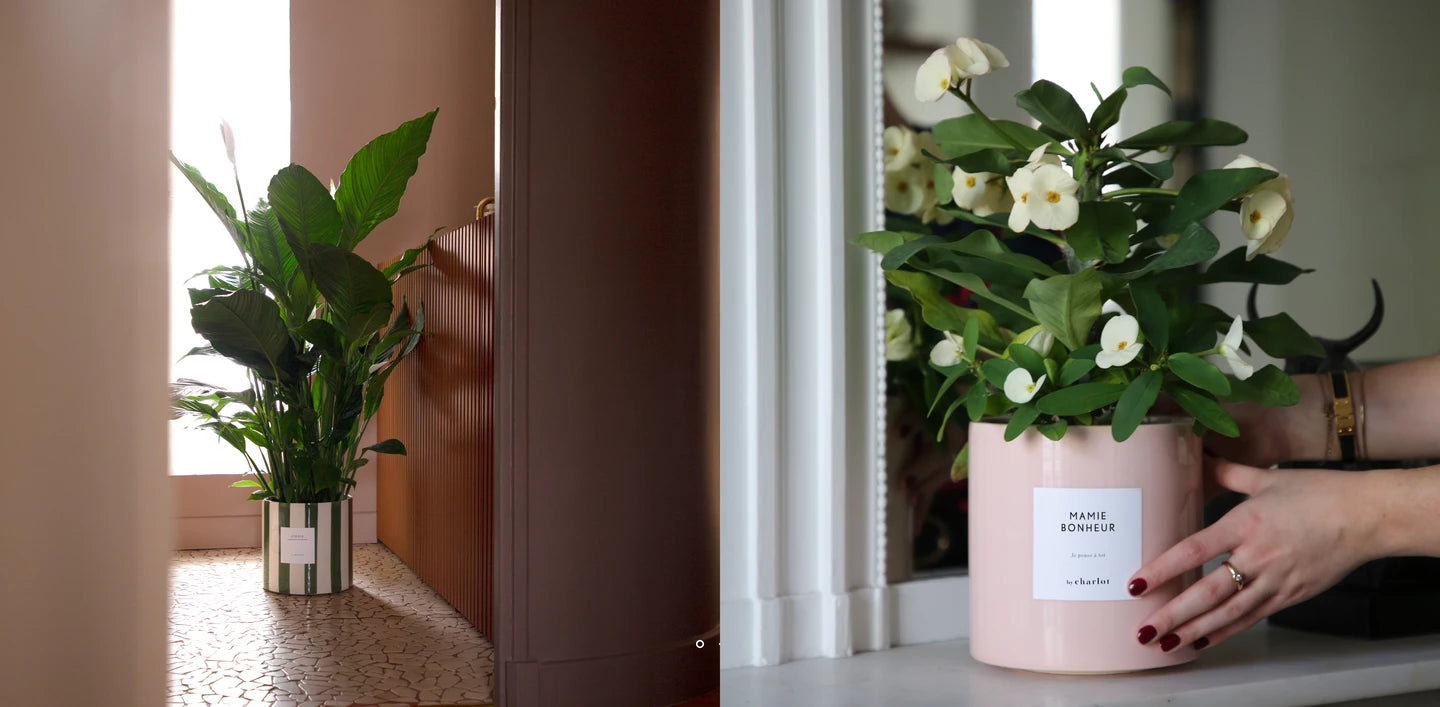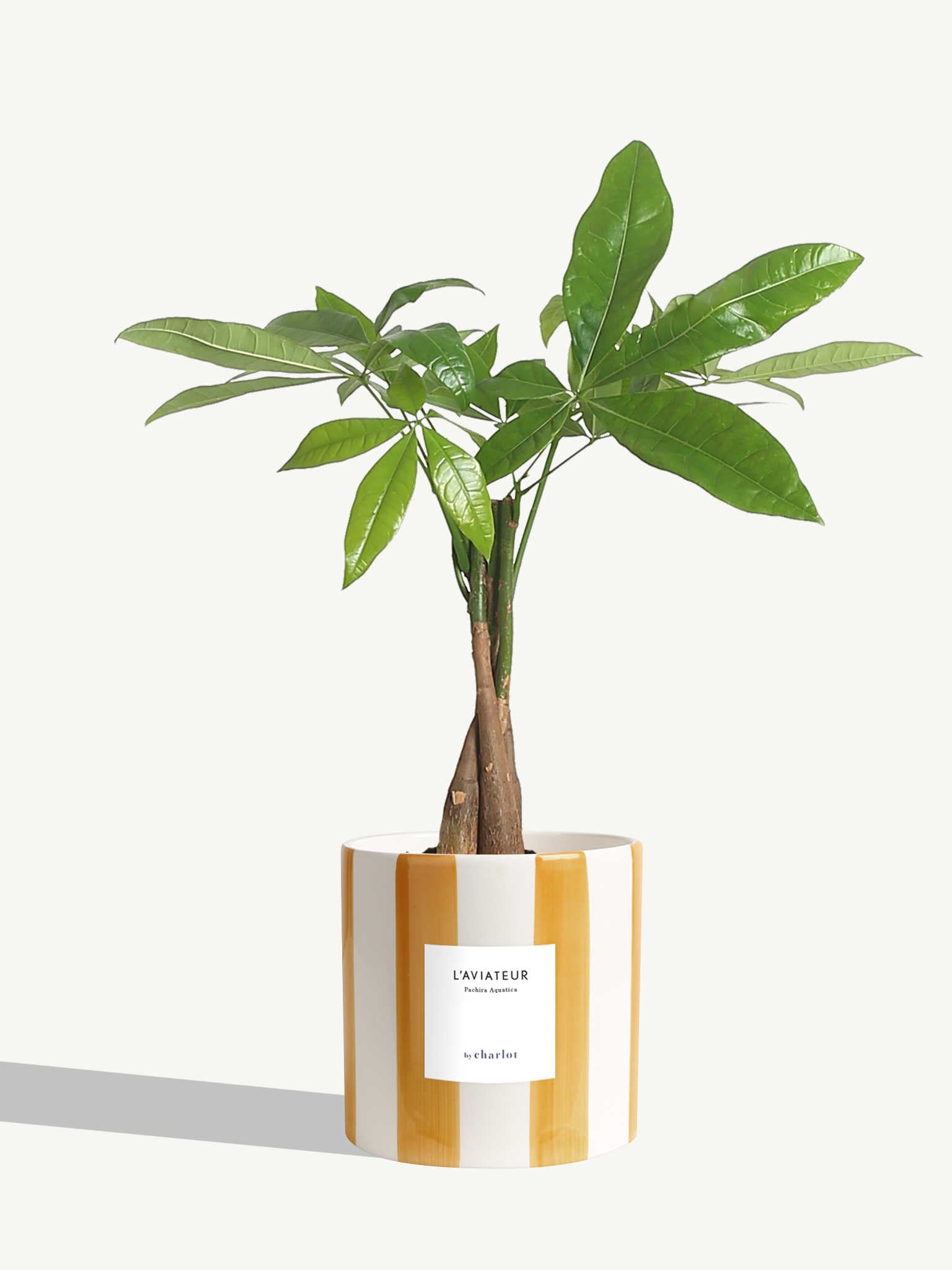Flowering plants add a touch of beauty to any indoor space. They offer a variety of colors and floral patterns that instantly brighten the atmosphere. These plants are perfect for those who want to bring a touch of nature into their home without the need for a garden.
At By Charlot, you'll find a variety of flowering plants, including La Distinguée and L'Idole . Their maintenance is quite simple. These flowering plants are not only an aesthetic addition to your home, but they also bring a peaceful and relaxing atmosphere while promoting a sense of well-being in your living space!
Image with text

How do I water my flowering plants?
Flowering plants are part of the houseplant family. They require frequent watering, always in small amounts.
In spring and summer, water your plants 1 to 2 times per week. As fall and winter approaches, we recommend reducing watering to once every 10-15 days, depending on the environment.
Image with text
Flowering plants are sensitive to the limescale present in tap water. Therefore, we recommend watering your plant with rainwater whenever possible. This can be difficult when living in an apartment. Therefore, before watering your plants with tap water, let your water aerate to reduce the limescale present in it.
Image with text
At By Charlot, we offer flowering plants in 2 different sizes , Large and Grandiose. This allows you to find the height that best suits you and your interior. It is important to note that flowering plants, like most indoor plants, are sensitive to overwatering , so it is essential not to overwater your plants.
Watering amounts and frequencies depend on your plant's exposure and indoor humidity levels. Recommendations for how much water to add vary depending on the plant's environment.
Since plants are living beings, caring for them isn't an exact science, so it's important to keep an eye on them to take the best possible care of them. To help you water your flowering plants, here are some tips based on their size:
- Large: Add a double espresso, or about 10 to 15 cl of water, to meet your plant's needs.
- Grandiose: Add a large glass of water, about 40 cl of water, to meet your plant's needs.
Image with text
When your plant needs water, there are several signs that can warn you. If its leaves are drooping or curling , your plant is lacking moisture; water it and it will be perfectly healthy.
We recommend waiting until the soil is dry before watering your plant again. Dry soil on the surface doesn't always indicate thirst. When in doubt, always touch the soil with your finger. If the soil is dry to 1.5 cm, you should water the plant. The soil is sometimes wetter than you think.
Image with text
Flowering plants need a bright environment to thrive. Place your plant in a room with natural sunlight and it will look even more beautiful. However, be careful of direct sunlight, which can burn its leaves. If your home is dimly lit, we do not recommend flowering plants, which do not adapt well to low light.

How do I know if my plant needs watering?
When your plant needs water, there are several signs that can warn you. If its leaves are drooping or curling , your plant is lacking moisture; water it and it will be perfectly healthy.
We recommend waiting until the soil is dry before watering your plant again. Dry soil on the surface doesn't always indicate thirst. When in doubt, always touch the soil with your finger. If the soil is dry to 1.5 cm, you should water the plant. The soil is sometimes wetter than you think.
Image with text
Flowering plants need a bright environment to thrive. Place your plant in a room with natural sunlight and it will look even more beautiful. However, be careful of direct sunlight, which can burn its leaves. If your home is dimly lit, we do not recommend flowering plants, which do not adapt well to low light.
Image with text
Pruning flowering plants can vary depending on the type of plant and its specific needs. For many flowering plants, the best time to prune is after flowering . Wait until the plant has finished flowering to avoid interrupting the flowering process. For summer-blooming plants, spring may be a good time to prune lightly to encourage healthy growth and abundant blooms.
Here are the different steps for pruning your flowering plant:
- Remove faded flowers regularly to encourage the plant to produce new flowers and extend the flowering period.
- Cut back dead, diseased, or damaged stems to promote healthy growth and prevent the spread of disease.
- To encourage denser growth and more abundant flowering, lightly prune the main stems to encourage new branches. To do this, use clean, disinfected pruning shears to cut the stems at their base.
Image with text
Pruning flowering plants can vary depending on the type of plant and its specific needs. For many flowering plants, the best time to prune is after flowering . Wait until the plant has finished flowering to avoid interrupting the flowering process. For summer-blooming plants, spring may be a good time to prune lightly to encourage healthy growth and abundant blooms.
Here are the different steps for pruning your flowering plant:
- Remove faded flowers regularly to encourage the plant to produce new flowers and extend the flowering period.
- Cut back dead, diseased, or damaged stems to promote healthy growth and prevent the spread of disease.
- To encourage denser growth and more abundant flowering, lightly prune the main stems to encourage new branches. To do this, use clean, disinfected pruning shears to cut the stems at their base.
Image with text
Here are the steps to follow when you want to repot your flowering plants:
- Take your plant, some potting soil and a slightly larger pot (a few centimetres larger in diameter).
Repotting is mainly done in early spring before your plant's growth and flowering period, approximately once every two years depending on the growth of your plant.
- Aerate the roots of your plant by gently shaking the root ball.
- Add potting soil to your new pot and place your plant inside. After adding soil almost to the top of your pot to allow for optimal watering, you can add a little water to your plant to settle the soil.
Your plant is now repotted. Place it in a bright room for optimal growth and flowering!
Image with text

My flowering plants are infested with small creatures: what should I do?
Your plants can sometimes be infested by certain insects including scale insects or red spiders .
- Mealybugs : If you have a white mass on the leaves of your plant, these are mealybugs.
Mix one dose of black soap in one liter of water and spray the mixture on your plant. Once this is done, we recommend removing any white clumps with a damp cloth. Be careful, as mealybugs can spread from plant to plant. Keep your caladium away from it while you treat it.
Spider mites : If you have spider mites on your plant, mist its leaves with water. These insects fear humidity and will disappear.
Image with text
Some flowering plants are suitable for pets, such as hibiscus.
However, the flowering plants By Charlot, L'Idole (Spathiphyllum Floribundum) and La Distinguée (Anthurium Andraeanum Linden) are not suitable for animals.
Image with text
Mold on the surface of your plant's soil can be caused by two factors. It could simply be soil that has dried too slowly, which is especially the case in winter. We recommend gently scraping the surface soil with a fork to avoid damaging your plant.
Mold can originate from the entire plant, resulting from overwatering and/or poor soil drainage . We recommend repotting your plant with well-draining potting soil and ensuring the soil is completely dry before watering your plant again. If you see white spots appearing on the surface of the soil, don't worry. This is due to limescale in the watering water.
Image with text
If your plant's leaves are dry, it's likely due to a lack of moisture . We recommend watering your plant lightly, making sure the soil is dry to a depth of 1.5 cm. Also, keep your plant away from any heat sources; radiators or fireplaces can dry out your plant.
Image with text
When your plant's leaves turn pale, it means it's lacking light . Flowering plants require a bright environment. We recommend placing your plant in a bright room, away from direct sunlight. This will help it regain its vibrant colors!
Image with text
Your plant's flowering time is limited. Therefore, at the end of flowering, it is normal for your plant to lose its flowers, which mainly happens at the end of summer .
If your plant's flowers are dropping prematurely, we recommend watering your plant well and maintaining good humidity levels. Premature flower drop can be caused by a lack of moisture.
Image with text

The Distinguished: Anthurium Andraeanum Linden
Anthurium Andraeanum Linden is a plant native to Central and South America.
The Distinguished is a large, easy-care plant . Its beautiful, bright red flowers will add a touch of color to your home.
Regarding its flowering period , this plant can produce flowers almost all year round under optimal growing conditions. However, the main flowering period is usually in spring and summer .
To encourage continued flowering, it is essential to provide the plant with proper care:
- A good amount of indirect light.
- Warm and stable temperatures (ideally between 20°C and 25°C).
- Regular but not excessive watering.
- High ambient humidity.
With this care, your anthurium will be able to flower indoors almost all year round.

The Idol: Spathiphyllum floribundum
Native to the tropical regions of South and Central America, Spathiphyllum floribundum, also known as "moonflower." Belonging to the Araceae family, this plant is prized for its lush, glossy leaves and elegant white flowers .
The Distinguished Flower can bloom year-round under the right growing conditions. For this, it's essential to provide your plant with bright, indirect light and a good level of humidity. Water your plant regularly to keep the soil moist, but not soggy, which can promote root rot.
With these special attentions, your plant will reward you with the flowering of graceful flowers that will brighten up your interior and bring a touch of lush nature to your environment.
Image with text
At By Charlot, we have a wide variety of personalized plants to beautify your interior, whether small plants , large plants or XXL plants . But also personalized cacti and outdoor plants . The plant boxes , themselves, offer you the possibility of composing a combination of By Charlot products according to your preferences.

















